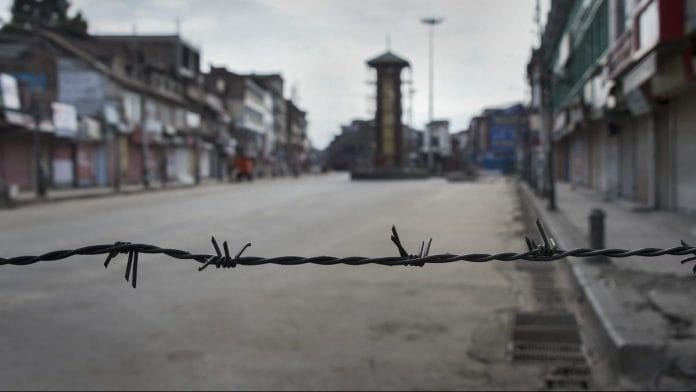Thank you dear subscribers, we are overwhelmed with your response.
Your Turn is a unique section from ThePrint featuring points of view from its subscribers. If you are a subscriber, have a point of view, please send it to us. If not, do subscribe here: https://theprint.in/subscribe/
The Kashmir region, situated at the crossroads of India, Pakistan, and China, has been the subject of disputes since 1947. The partition of British India led to an ongoing dispute over Kashmir, with regions currently administered by India, Pakistan, and, to some extent, China. Calls for independence have surfaced periodically, driven by unique cultural identity, political autonomy aspirations, and local grievances.
Understanding the roots of Kashmir’s independence movement requires examining the region’s partition-era history. At independence, Kashmir’s princely ruler chose accession to India under duress, leading to conflict and the first Indo-Pakistani war. The 1949 UN ceasefire line divided Kashmir between India and Pakistan. A 1948 UN resolution recommended a plebiscite for Kashmir, yet it has not been implemented due to disagreements and subsequent wars between India and Pakistan in 1965 and 1971. India’s decision in 2019 to revoke Article 370, which granted limited autonomy to Jammu and Kashmir, intensified calls for self-determination. This complex geopolitical context has led to heightened nationalist sentiments within Kashmir, with some factions advocating for independence as the most viable path to peace and self-governance.
Assessing the economic feasibility of an independent Kashmir involves examining its current economy, potential revenue sources, and the challenges it may face. Kashmir’s economy is primarily agrarian, with strengths in horticulture, handicrafts, and tourism. Agriculture accounts for about 50% of Kashmir’s GDP, while tourism has been a significant contributor, especially prior to regional instability. However, militancy and conflict have periodically hindered tourism and investments. Kashmir has abundant natural resources, including forests and freshwater lakes. Its rivers provide hydroelectric potential that could offer significant energy revenues. An independent Kashmir could potentially control these resources, gaining revenue from water-sharing agreements with India and Pakistan. Landlocked and mountainous, an independent Kashmir would likely depend on neighboring countries for trade access. However, strategic position could allow for trade routes between Central and South Asia if relations with neighbors stabilize. Economic models of small, resource-rich states like Bhutan or Kyrgyzstan offer mixed insights. While such states face challenges due to limited internal markets, they can leverage regional trade and strategic partnerships.
An independent Kashmir would face complex challenges in establishing a stable political system, given its ethnic, linguistic, and religious diversity. Kashmir’s population is a blend of various ethnic and religious groups, including Muslims, Hindus, and Buddhists, with regional identities in Jammu, Kashmir Valley, and Ladakh. Building inclusive governance structures would be essential to prevent sectarian conflict and ensure equitable representation. Independence would require creating stable political institutions from scratch. Kashmir would need robust security institutions to handle internal security challenges and manage cross-border tensions. The region’s history of militancy may require international assistance or peacekeeping missions to ensure stability.
Achieving sustained human development would be a priority for an independent Kashmir, given its population’s reliance on agriculture, limited industrialization, and dependence on imports. Kashmir’s youth unemployment rate is high, especially among educated young people. Investment in education, skills training, and employment opportunities would be critical to mitigate the risk of disillusionment and insurgency among the youth. Kashmir’s healthcare infrastructure is under-resourced, a challenge that an independent administration would need to address. The region could benefit from aid and partnerships to improve medical facilities, especially in rural areas.
Ensuring human rights protections would be paramount. An independent Kashmir would need to work toward a legal system that respects freedoms, ensuring stability and justice for its citizens.
Regional security would be the most challenging aspect of an independent Kashmir due to its location between nuclear powers. India and Pakistan view Kashmir as strategically and symbolically crucial, while China controls Aksai Chin. An independent Kashmir would need to secure its borders, possibly requiring India, Pakistan and China to agree to guarantee its neutrality which can be achieved by a negotiated settlement between all stakeholders. Without robust security and economic opportunities, there is a risk of internal instability and social conflict.
Several recent examples of small nations achieving independence provide lessons. Despite significant international support, South Sudan has struggled with civil conflict due to ethnic divisions and a lack of infrastructure. This highlights the risks an independent Kashmir might face without sufficient institutional support. Kosovo’s partial international recognition and dependence on international aid for stability reflect the difficulties small, disputed territories face in achieving full sovereignty. Bhutan, while landlocked and economically limited, has managed to balance regional relations and economic self-sufficiency, offering insights into sustainable governance for small states.
The case for an independent Kashmir involves significant complexities and challenges. While independence may offer the region self-governance, cultural preservation, and resource control, achieving economic self-sufficiency, political stability, and security would be formidable tasks. A potential path could involve phased autonomy or internationally brokered agreements, allowing Kashmiris greater control while managing regional tensions.
Ultimately, the decision involves weighing the aspirations of Kashmir’s people with the practical considerations of nationhood in a geopolitically sensitive region. Future pathways for Kashmir, including independence or increased autonomy within a federated structure, will require carefully balanced regional diplomacy, sustainable development strategies, and robust governance models.
These pieces are being published as they have been received – they have not been edited/fact-checked by ThePrint


